New game
New game (Japanese: さいしょから はじめる start from the beginning) is an option available from the main menu to start a new game.
In the core series
Starting a new game
In all games up to Generation V, there is a "new game" option at the main menu. This option remains available even if a previous game was already saved.
From Generation VI onwards, the "new game" option was removed. If there is no saved game, a new game starts automatically. If there is a saved game, the player will be able to continue it.
Existing save file
In all games up to Generation III, a new game can be created with no restrictions, even if there is already an existing saved game. If the player saves when playing the new game, this will erase the previous game.
In Generations IV and V, if there is already a saved game, the player may create a new game where it is impossible to save, in order to preserve the existing save file. There is a warning at the start, informing the player that they won't be able to save the current game. The "Save" function remains in the menu as usual during gameplay, but all attempts to save will fail. Once the game system is turned off, all progress in the new game will be lost.
- In Generation IV and Pokémon Black and White, if the player becomes a Champion in this new game where it is impossible to save, the game will reset automatically as usual, and all progress will be lost at this point.
- In Pokémon Black 2 and White 2, the game softlocks in Pokéstar Studios once the player would be normally required to save the game.
Alternatively, the player can manually delete the previous saved game in Generations IV and V by pressing ↑ + Select + B at the title screen. The game will ask for confirmation before deleting it. Once the previous saved game is deleted, the player will be able to create a new game and then save it normally.
From Generation VI onwards, it's simply not possible to create a new game if a previously saved game exists. However, the player is able to delete a previously saved game (by pressing ↑ + X + B in Generations VI and VII, or using the console's setting in Generation VIII) before starting a new game.
Selecting the language
In all games up to Generation V, each game cartridge has a single language.
From Generation VI onwards, there are multiple languages available in a single game, and the player is asked to choose a language at the start. The language may not be changed without starting a new game.
Game information

In Pokémon FireRed and LeafGreen, the controls are explained at the start, and there is a short text introduction about the game.
In Generation IV, there is an initial screen with help about the game as well. It includes the options: "Control info", "Adventure info", and "No info needed".
Setting the time
- Main article: Time
In Pokémon Gold, Silver, and Crystal only, an unidentified voice (possibly Professor Oak) asks the player to set the time (hours and minutes) when starting a new game.
This is not needed in Generation I, as well as their remakes Pokémon FireRed and LeafGreen, which lack a clock function entirely. In Pokémon Ruby, Sapphire, and Emerald, the player is required to set the time shortly after creating a new game, once they enter their room for the first time, in the player's house.
From Generation IV onwards, the time is managed by the game system (such as the Nintendo DS, 3DS, or Switch) and does not require to be adjusted in the Pokémon game.
Introduction to the Pokémon world
In all games, someone introduces the player to the Pokémon world.
Prior to Rose in Pokémon Sword and Shield, the game is introduced by Pokémon Professors; they also mention their specific line of research for studying Pokémon.
Pokémon example
A Pokémon is shown as an example by the person who introduced the player to the Pokémon world.
| Kanto | Johto | Hoenn | |||||
|---|---|---|---|---|---|---|---|
| RB | Y | FRLG | PE | GSHGSS | C | RSORAS | E |
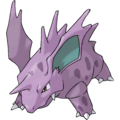 Nidorino |
 Pikachu |
 Nidoran♀ |
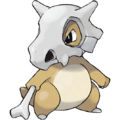 Cubone |
 Marill |
 Wooper |
 Azurill |
 Lotad |
| Sinnoh | Unova | Kalos | Alola | Galar | Paldea | ||
|---|---|---|---|---|---|---|---|
| DPBDSP | Pt | BW | B2W2 | XY | SMUSUM | SwSh | SV |
 Munchlax |
 Buneary |
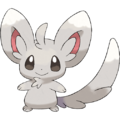 Minccino |
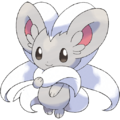 Cinccino |
 Skiddo |
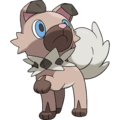 Rockruff |
 Cufant |
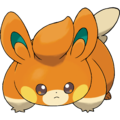 Pawmi |
Color palette (Generation I)
In the Generation I games, NidorinoRGB and PikachuY have slightly different colors in the new game intro than usual.
In main gameplay, Nidorino uses the purple Pokémon color palette (index number 0x14) and Pikachu uses the yellow Pokémon color palette (index number 0x18). However, when shown as a Pokémon example in the new game, they both use the same color palette (index number 0x10) as the player, the rival, and Professor Oak instead. This palette is also used by Mew, Mewtwo, and Jynx (except the Virtual Console Jynx).
Color comparison:
- In Pokémon Red and Blue, Nidorino (using the color palette 0x10) is purple with a shade of light pink in the new game (like Mew and Mewtwo), while it is completely purple instead in normal gameplay.
- In Pokémon Yellow (which uses different colors for the palette 0x10), Pikachu has red cheeks in the new game, but dark brown cheeks in normal gameplay (again like Mew and Mewtwo, which are also colored red and yellow in this game).
Nidorino's cry
Due to an oversight in Pokémon Red and Blue (as well as Japanese Pokémon Red, Green, and Blue), Nidorino makes the cry of Nidorina.
Shiny Pokémon

In the Generation V games, Professor Juniper's MinccinoBW or CinccinoB2W2 seen at the new game can be Shiny.
Music theme

|
This section is incomplete. Please feel free to edit this section to add missing information and complete it. Reason: Missing SWSH & SV music |
These are the music themes played during the new game cutscenes.
| Music theme | Games |
|---|---|
| Road to Cerulean City: Leaving Mt. Moon | RGBYFRLGPE |
| Route 30 | GSCHGSS |
| Route 122/123 | RSEORAS |
| Professor Rowan's Introduction | DPPtBDSP |
| Route 4 (Spring) | BWB2W2 |
| Kalos Region Theme | XY |
| Welcome to the Alola Region | SMUSUM |
Player's gender
In Generation I and in Pokémon Gold and Silver, only a male player character is available.
From Pokémon Crystal to Generation VI, the player is asked if they are a boy or a girl. In Pokémon Crystal, an unidentified voice (possibly Professor Oak) asks the player's gender at the start. In the later games, this is asked by the person who introduced the Pokémon world.
From Generation VII onwards, the player is not asked that question anymore. There are simply male and female options when the player is asked about their appearance.
Player's appearance
From Generation VI onwards, except in Pokémon Omega Ruby and Alpha Sapphire, there are multiple options of male or female player's appearance when the player starts a new game. They include multiple skin tones, eye colors, and hair colors.
In Pokémon X and Y, the player is asked about their gender first, and then presented the options of appearance for the chosen gender. From Generation VII onwards, the player is not directly asked about their gender. Instead, the male and female options are simply presented together when the player is asked about their appearance.

|

|
| Calem (Pokémon X and Y) |
Serena (Pokémon X and Y) |

|

|
| Elio and Selene (Pokémon Sun and Moon) |
Elio and Selene (Pokémon Ultra Sun and Ultra Moon) |

|
| Chase and Elaine (Pokémon: Let's Go, Pikachu! and Let's Go, Eevee!) |

|
| Victor and Gloria (Pokémon Sword and Shield) |

|
| Lucas and Dawn (Pokémon Brilliant Diamond and Shining Pearl) |

|
| Rei and Akari (Pokémon Legends: Arceus) |

|
| Florian and Juliana (Pokémon Scarlet and Violet) |
Player's name
In all core series games, the player is asked their name when creating a new game. Once the name is written, the player is asked if the name is correct, and they have the chance to choose again if needed. Once the name is chosen, it can't be changed without creating a new game.
In Generations I and II, as well as Pokémon Ruby and Sapphire, there is a short list of name suggestions that can be picked, in addition to the option of writing the name.
In Pokémon FireRed, LeafGreen, and Emerald, as well as all Generation IV games, there is no list of names, but a suggested name automatically appears if the player attempts to leave their name blank. The player can accept that name suggestion or go back to write another name. It's also possible to see other name suggestions by coming back and leaving the name blank again.
From Generation V onwards, the player is always required to type their own name. There is no list of suggestions, and leaving their name blank will not cause any name suggestion to appear.
Up to Generation III, the name suggestions are written in capital letters (such as the name "RED"), while in Generation IV they are written with regular capitalization (such as the name "Diamond"). This is also the name style used by non-player characters. However, the player can type using both uppercase and lowercase letters in all games. Additionally, there are different name suggestions depending on the game language, such as English, Japanese, French, German, Italian, Spanish, and Korean.
Rival's name
In some games, the player is required to choose a name for a rival when creating a new game:
Conversely, this rival's name is not chosen when creating a new game, but is chosen later in the game's storyline:
The rivals Blue and Barry have a short list of suggested names as well. Additionally, if the player leaves a blank name for Blue in FireRed and LeafGreen, for Barry or Silver in the Generation IV games, a suggested name is used automatically for them, which the player may accept or not.
The rival's name suggestions use the same capitalization as the player's (all caps up to Generation III, but regular capitalization in Generation IV). There are different name suggestions based on the game language as well.
From Generation III onwards, several core series games have rivals with predefined names that cannot be changed, such as Brendan, May, and Wally as rivals in Pokémon Ruby, Sapphire, and Emerald and their remakes Pokémon Omega Ruby and Alpha Sapphire.
Additional events
These are additional events seen when creating a new game.
- In all games up to Generation V, there is a short animation where the player character shrinks into the player sprite.
- In Pokémon Diamond, Pearl, Platinum, Brilliant Diamond, and Shining Pearl, there is a TV news piece (shown as a piece of text) about an exploration team that failed to find the red Gyarados. This is a special report named "Search for the red Gyarados!", brought by Jubilife TV on Nationwide Net. The player character is shown to be watching this TV show in their room.
- In Pokémon Black 2 and White 2, the current season is displayed, followed by a cutscene of Aspertia City, with the text "Game Freak Presents, followed by "Pokémon Black Version 2" or "Pokémon White Version 2", depending on the current game version. In this cutscene, the player's Mom receives a Xtransceiver call from Professor Juniper. In this call, Professor Juniper says that Bianca is going to deliver a Pokédex for the player character. After their call is over, Mom enters the house and asks the player if they want to have a Pokémon and a Pokédex; the player must accept both or else she will ask again. Once Mom informs the player that Bianca is going to deliver a Pokémon and a Pokédex to them, the player leaves the house and meets Hugh and his sister.
Starting place
In most games, the player starts the game in their room, located at the player's house. However, in Pokémon Ruby, Sapphire, and Emerald and their remakes Pokémon Omega Ruby and Alpha Sapphire, the player starts at the Inside of Truck. The truck moves the player to their new home in Littleroot Town, Hoenn. In Pokémon Legends: Arceus, the player starts at Prelude Beach.
See also

|
This game mechanic article is part of Project Games, a Bulbapedia project that aims to write comprehensive articles on the Pokémon games. |









